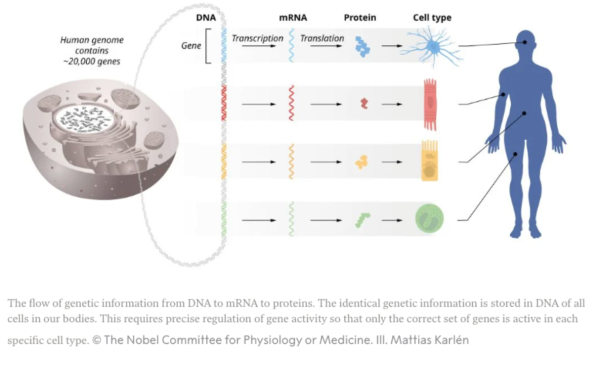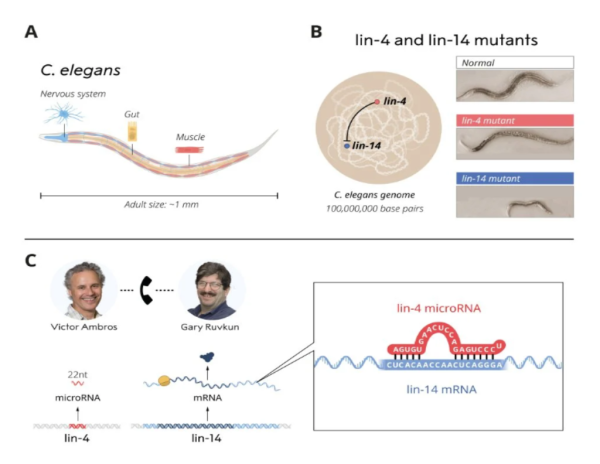Created in 1901 by Afred Nobel, the Nobel Prize is a renowned award given on the anniversary of Nobel’s death “to those who, during the preceding year, shall have conferred the greatest benefit on mankind.” Each recipient of the Nobel Prize wins a 24 karat gold plated medal, a diploma, and a monetary sum of roughly $1,035,000 dollars which is divided amongst the winners in each field. However, more than anything, the Nobel Prize brings a large amount of recognition to heroes who are paving the way forward in their respective fields. This year’s Nobel Prize winners in medicine, Victor Ambros and Gary Ruvkun, were commended for their discovery of microRNA and its role in post-transcriptional gene regulation.

Figure 1 Winners of the Nobel Prize Victor Ambros (left) and Gart Ruvken (right)
If this sounds complex, you’re not alone—I was initially puzzled too. To break this down, every cell in our body contains genetic information which plays a vital role in our bodies. It is the blueprint for our cells to perform functions like synthesizing proteins, which then can play a major part in cell structure, or enzymes, which speed up reactions. As journalist Sam Kean for Psychology Today writes, “DNA is software, proteins are hardware, cells are factories. Genes are like the story, and DNA is the language that the story is written in.”
DNA (deoxyribose nucleic acid) is extremely critical to the proper function of our cells because without it, our cells would not be able to synthesize essential materials. It’s important to note that each cell in our body contains all the genetic information and genes for all the cells in the body. But as the Nobel Assembly at Karolinska Institute writes, “Different cell types, such as muscle and nerve cells, have very distinct characteristics. How do these differences arise? The answer lies in gene regulation, which allows each cell to select only the relevant instructions. This ensures that only the correct set of genes is active in each cell type.”

Winners Victor Ambros and Gary Ruvkun are two scientists curious about how gene regulation occurs. They discovered microRNA, not to be confused with messenger RNA, which plays a critical role in gene regulation. Their pioneering discovery unveiled a novel principle of gene regulation that is crucial for multicellular life, including humans. It’s now recognized that the human genome encodes over a thousand microRNAs. This unexpected finding introduced a new aspect of gene regulation, with microRNAs playing a vital role in the development and function of organisms.
Mattias Karlén, a member of the Nobel Committee for Physiology or Medicine, states, “In the 1960s, it was shown that specialized proteins, known as transcription factors, can bind to specific regions in DNA and control the flow of genetic information by determining which mRNAs are produced.” In other words, a specific protein called a transcription factor connects to a part of the DNA to regulate what mRNAs are produced, hence only expressing certain genes. This was thought to be the complete picture. In 1980, Ambros and Ruvkun were postdoctoral fellows at Robert Horvitz’s laboratory. They studied a tiny worm called C. elegans to learn how genes control the timing of development. Despite its size, the C. elegans contains many specialized cells, such as neurons and muscle cells. They focused on two genetic mutation strains of worms, lin-4 and lin-14 , which showed defects in developmental timing. Ambros discovered that the lin-4 gene creates a very small RNA molecule, which was later named microRNA. This microRNA could turn off the lin-14 gene, meaning it prevented lin-14 from being active and producing proteins. This was a new way of controlling gene activity that didn’t involve making proteins but rather stopping certain genes from doing their job. At the same time in Massachusetts General Hospital and Harvard Medical School, Ruvkun discovered that this microRNA attached to lin-14’s genetic message and blocked it from making a protein, which was a new way of regulating genes. Then the two researchers compared their data and decided to join forces. Their discovery was often dusted off as only applicable to C. elegans’ genes, but that was proved false when Ruvkun’s research group discovered another type of microRNA let-7 which is found in many species in the Animal Kingdom. This was a huge discovery because we now know that thousands of these microRNAs exist in humans and help regulate genes in all complex life forms! This has a key role in fine-tuning gene activity and protecting cells.

From their studies, it was discovered that a single microRNA can regulate the expression of many different genes and also that a single gene can be regulated by multiple microRNAs. Furthermore, it was found that microRNA can also code to create complimentary copies of themselves.
While all this might seem insignificant to the everyday person, the truth is that this has a significant real world impact. Though it is known to regulate gene expression, microRNA plays a deeper role in many aspects of cell function, such as growth and disease prevention. In medicine, microRNAs are being studied as potential biomarkers for diagnosing genetic diseases such as cancer and diseases like sickle cell anemia. It has been found that changes in microRNA levels are often linked to higher chances of lower health conditions. By manipulating microRNAs, researchers hope to reprogram gene expression patterns and develop new treatments for a range of diseases. Although the development of micro RNA-based therapies is still in its early stages, it has generated considerable excitement and offers the potential for groundbreaking treatments in the future
Works Cited:
- Britannica, The Editors of Encyclopaedia. “Nobel Prize”. Encyclopedia Britannica, 12 Oct. 2024, https://www.britannica.com/topic/Nobel-Prize. Accessed 12 October 2024.
- “Nobel Prize.” Wikipedia, Wikimedia Foundation, 11 Oct. 2024, en.wikipedia.org/wiki/Nobel_Prize.
- Karlén, Mattias. “The Nobel Prize in Physiology or Medicine 2024.” NobelPrize.Org, The Nobel Committee for Physiology or Medicine. , 7 Oct. 2024, www.nobelprize.org/prizes/medicine/2024/press-release/.

